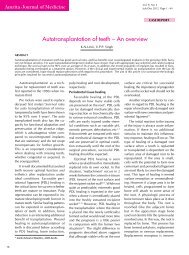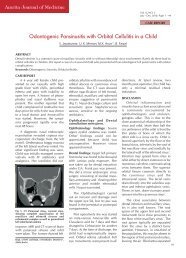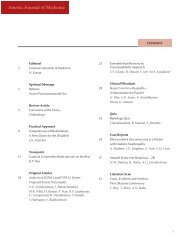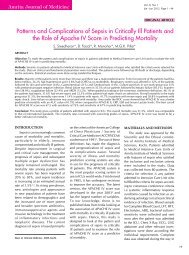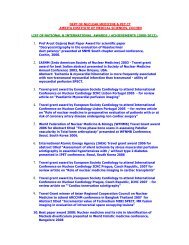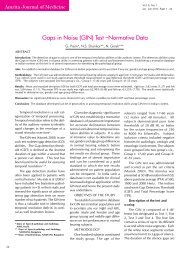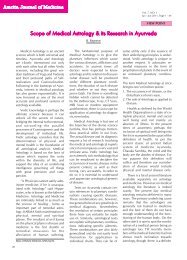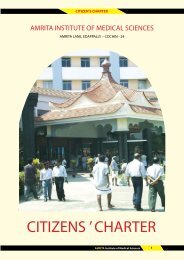Journal of Medicine Vol 2 - Amrita Institute of Medical Sciences and ...
Journal of Medicine Vol 2 - Amrita Institute of Medical Sciences and ...
Journal of Medicine Vol 2 - Amrita Institute of Medical Sciences and ...
Create successful ePaper yourself
Turn your PDF publications into a flip-book with our unique Google optimized e-Paper software.
<strong>Amrita</strong> <strong>Journal</strong> <strong>of</strong> <strong>Medicine</strong><br />
Nanosciences Research at the Health <strong>Sciences</strong> Campus <strong>of</strong> <strong>Amrita</strong> Vishwa Vidyapeetham<br />
velop in the near future. This includes the toxicological<br />
effects <strong>of</strong> nanomaterials, use <strong>of</strong> naturally occurring materials<br />
in nanomedicine <strong>and</strong> the development <strong>of</strong><br />
nanostructured materials for solar energy applications.<br />
ACNS will also have a strong academic focus with a<br />
college <strong>of</strong> nanosciences devoted to the training <strong>of</strong> the<br />
next generation <strong>of</strong> Indian nanotechnologists,<br />
nanobiotechnologists <strong>and</strong> nanomedical scientists. A beginning<br />
to this is the start <strong>of</strong> a two-year Master <strong>of</strong><br />
Technology program in Nanomedical <strong>Sciences</strong> that is starting<br />
in August 2007 with 30 students admitted each year.<br />
The focus <strong>of</strong> this Master <strong>of</strong> Technology program is to<br />
provide a fundamental underst<strong>and</strong>ing <strong>of</strong> nanomaterials<br />
sciences that have applications in the medical sciences<br />
as well as a thorough training in the medical sciences<br />
relevant to current potential applications.<br />
TISSUE ENGINEERING<br />
The coinage “tissue engineering” immediately <strong>and</strong><br />
correctly implies a combination <strong>of</strong> the disciplines <strong>of</strong> biology<br />
<strong>and</strong> technology. Modern tissue engineering took<br />
its birth in the late 1980s in Boston, USA, through the<br />
pioneering efforts <strong>of</strong> Dr. Joseph Vacanti <strong>of</strong> Boston<br />
Children’s Hospital <strong>and</strong> Dr. Robert Langer <strong>of</strong> Massachusetts<br />
<strong>Institute</strong> <strong>of</strong> Technology 4 . The basic concept involves<br />
the development <strong>of</strong> a scaffold into which are introduced<br />
appropriate cells that eventually multiply into the tissuespecific<br />
cells <strong>and</strong> regenerate the target tissue. The dream<br />
is that this approach can eventually regenerate an entire<br />
organ although that reality is still fairly distant. Much <strong>of</strong><br />
the current research in the world is focused on how to<br />
exp<strong>and</strong> the cells in vitro in the scaffold so that one can<br />
generate sufficiently large volumes starting with limited<br />
cells <strong>and</strong> how to prevent cell death during subsequent<br />
implantation. Since mature cells can only be exp<strong>and</strong>ed<br />
to a very limited extent much research is focused on the<br />
use <strong>of</strong> stem cells, <strong>and</strong> even here, tissue-specific adult<br />
stem cells may be the choice <strong>of</strong> the future 4 .<br />
One role <strong>of</strong> nanotechnology in tissue engineering is<br />
the ability <strong>of</strong> nanomaterials to more efficiently exp<strong>and</strong><br />
cells. This has been observed in our labs at the ACNS<br />
where our preliminary observations show more efficient<br />
attachment <strong>and</strong> proliferation <strong>of</strong> cells on nanostructured<br />
surfaces 5 . A second role that nanomaterials can play is in<br />
controlling the chemical <strong>and</strong> mechanical properties <strong>of</strong><br />
scaffolds. Nanoparticle reinforcements can effectively<br />
influence the strength as well as the biodegradability <strong>of</strong><br />
the scaffold. This property becomes important when implantation<br />
is done before complete tissue regeneration.<br />
In this case, the scaffold must temporarily fulfill the<br />
mechanical functions <strong>of</strong> the tissue. Further, in many cases<br />
<strong>of</strong> tissue engineering, the scaffold is designed to be biodegradable<br />
<strong>and</strong> ideally the degradability is matched so<br />
that degradation is complete when the tissue has fully<br />
regenerated. There is work that shows that nanoparticles<br />
tend to enhance material degradability 6 <strong>and</strong> can therefore<br />
be used to tune the degradability <strong>of</strong> scaffolds.<br />
Currently at ACNS we are developing novel methods<br />
to process scaffolds out <strong>of</strong> many c<strong>and</strong>idate biodegradable<br />
materials, including naturally occurring materials,<br />
such as chitosan. One useful technique, developed in<br />
the 90s in the US is electrospinning 7 , which is capable <strong>of</strong><br />
readily generating nan<strong>of</strong>ibrous materials, which have a<br />
strong resemblance in structure to the extracellular matrix<br />
8 . At <strong>Amrita</strong> we are exploring different ways <strong>of</strong><br />
controlling nanostructure <strong>and</strong> microstructure using<br />
electrospinning 9 .<br />
EARLY DIAGNOSTICS AND DRUG<br />
DELIVERY<br />
An exciting discovery that propelled the field <strong>of</strong><br />
nanobiotechnology is that material particles in the<br />
nanosize regime have strong interactions with other biological<br />
nanomaterials, such as, protein, DNA, enzymes,<br />
antigens, antibodies <strong>and</strong> cellular receptors, allowing them<br />
to be used as highly efficient biological probes 10 . A particularly<br />
attractive choice is a semiconductor nanoparticle<br />
in the size regime under 10 nm. Such particles, termed<br />
quantum dots, exhibit luminescence <strong>of</strong> wavelength that<br />
is strongly particle size dependent <strong>and</strong> hence are perfectly<br />
suited for diagnostic imaging <strong>of</strong> specific cells. The Department<br />
<strong>of</strong> Biotechnology, Government <strong>of</strong> India is<br />
supporting a project at ACNS for the development <strong>of</strong> targeted<br />
quantum dots for early detection <strong>of</strong> oral cancer.<br />
The approach we are taking is to bi<strong>of</strong>unctionalize quantum<br />
dots with antibodies targeted to known cancer<br />
biomarkers either in tumor cells or, more interestingly,<br />
in what are known as cancer stem cells – rare pre-cancerous<br />
cells with indefinite potential for self-renewal 11 .<br />
NANOSURFACE BIOENGINEERING<br />
The most well recognized property <strong>of</strong> the nanoscale<br />
is its extremely high surface activity. Indeed a rough<br />
calculation will show that at a particle size <strong>of</strong> about 2<br />
nm 100% <strong>of</strong> the atoms reside on the surface, <strong>and</strong> therefore<br />
every single atom is capable <strong>of</strong> reacting with the<br />
environment. If this environment is biological, such as,<br />
when there are protein molecules or cells with nanoscale<br />
receptors on the surface, there is the potential for an unusually<br />
strong interaction <strong>of</strong> the material with the<br />
biological environment. Using this principle, at <strong>Amrita</strong><br />
we have been taking conventional implant materials like<br />
Ti <strong>and</strong> providing nanoscale features on the surface by<br />
various methodologies such as, laser treatments,<br />
nanochemistry <strong>and</strong> electrochemistry to provide surfaces<br />
ranging from the nanoscale to the microscale <strong>and</strong> then<br />
studying the cell-surface interactions 5 .<br />
22



